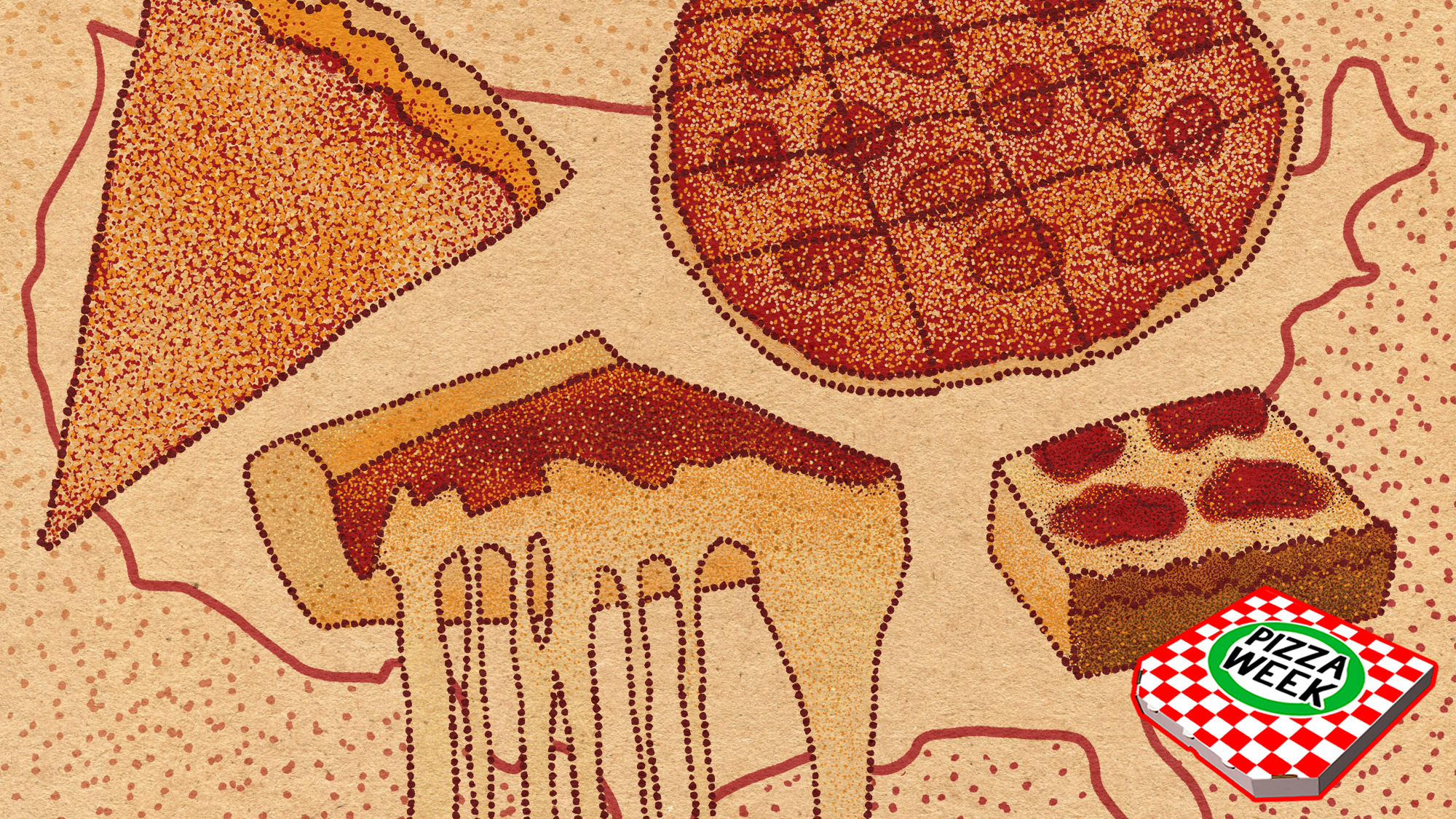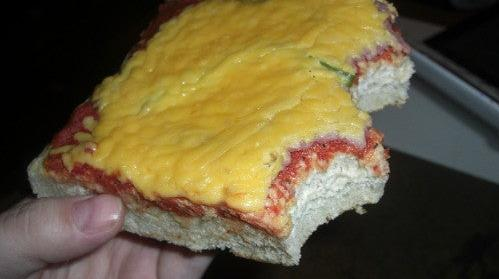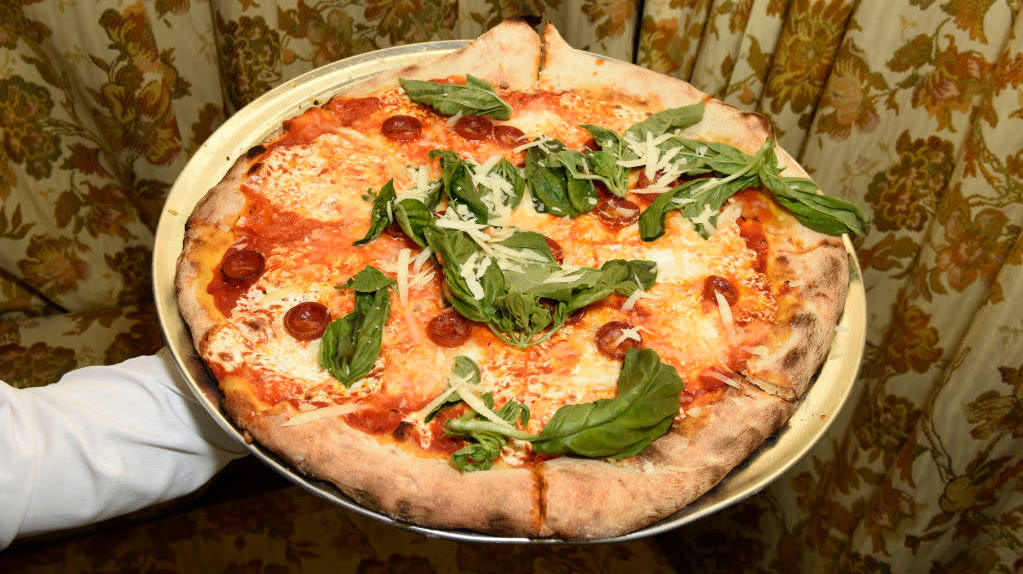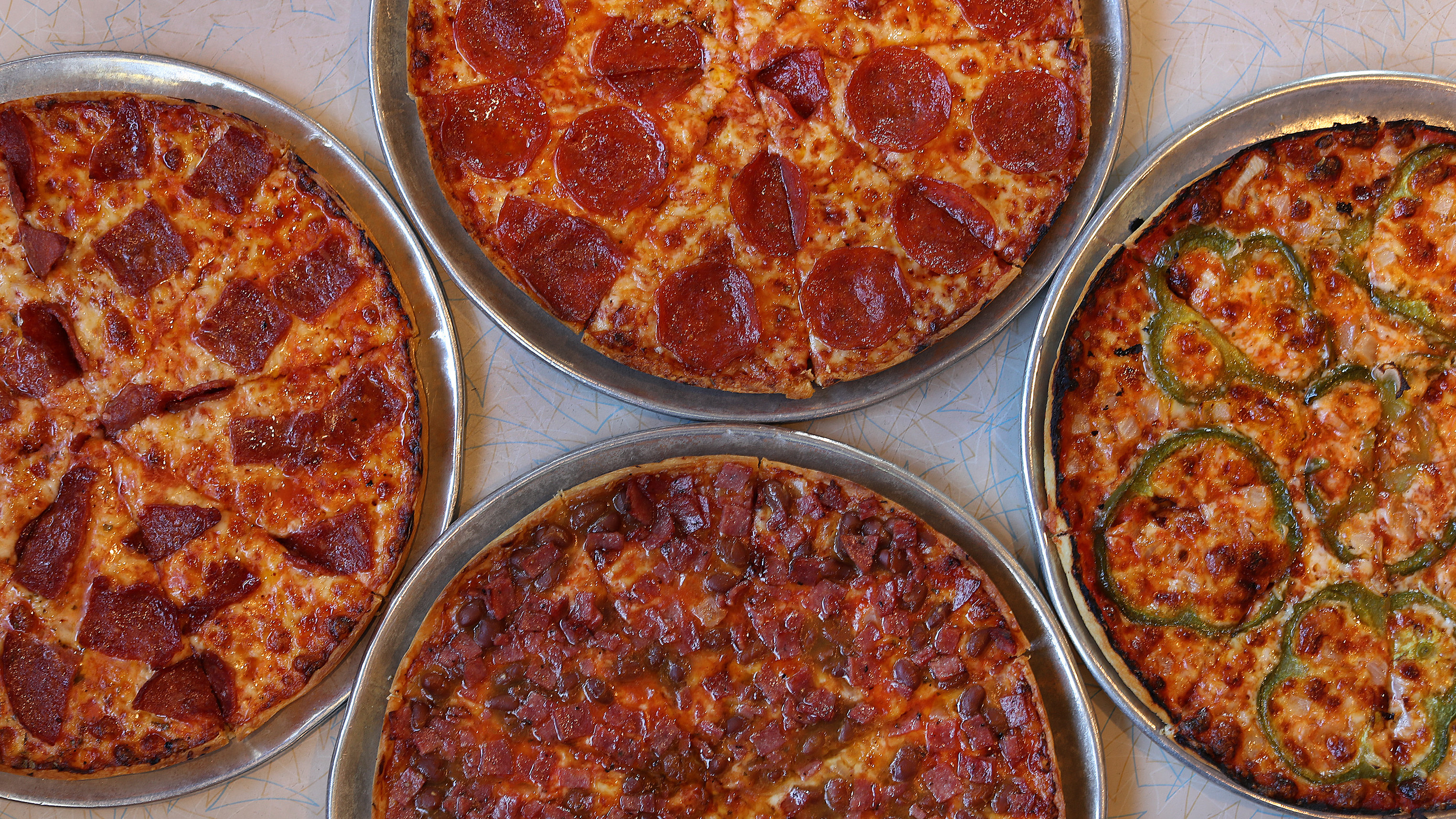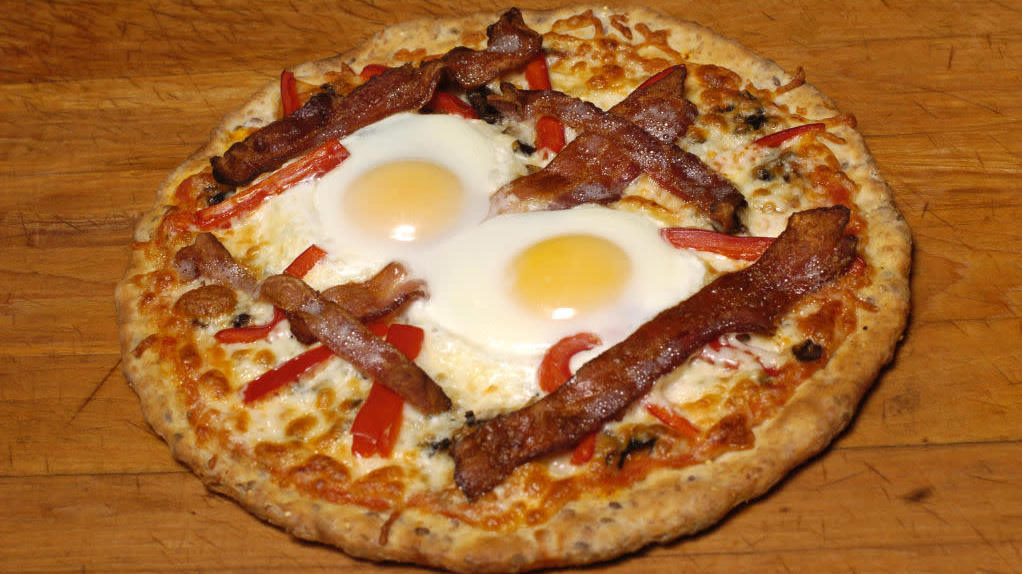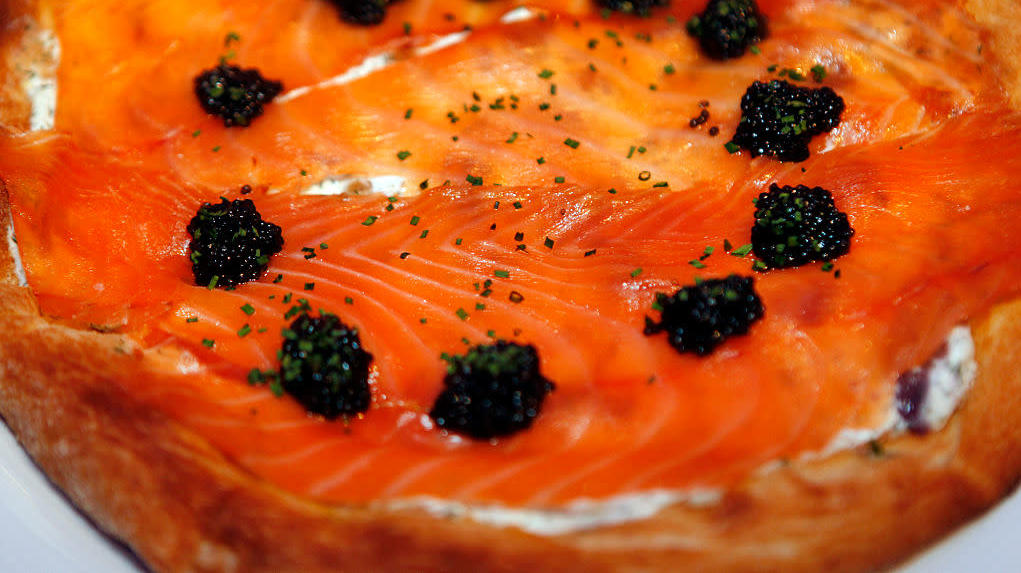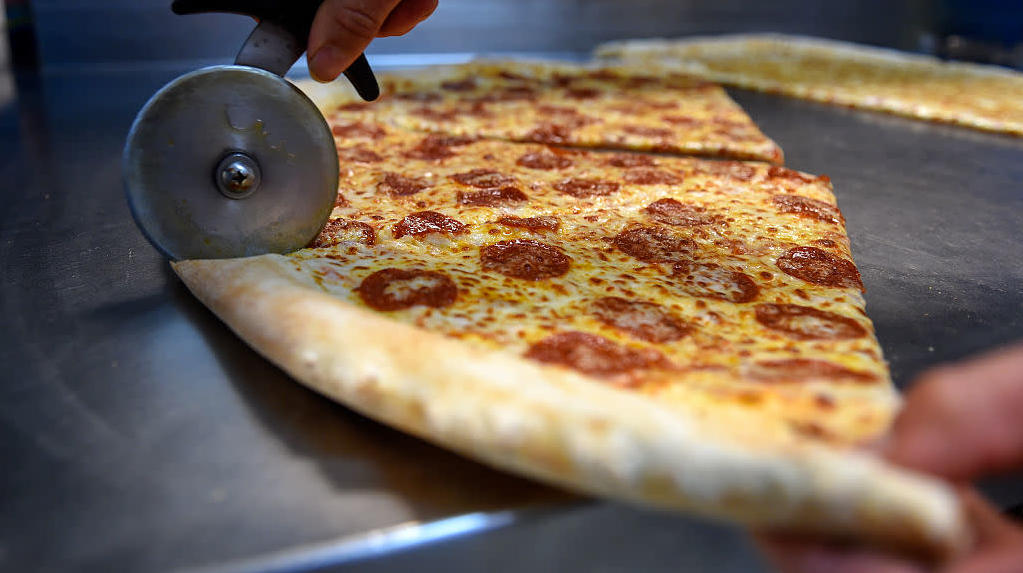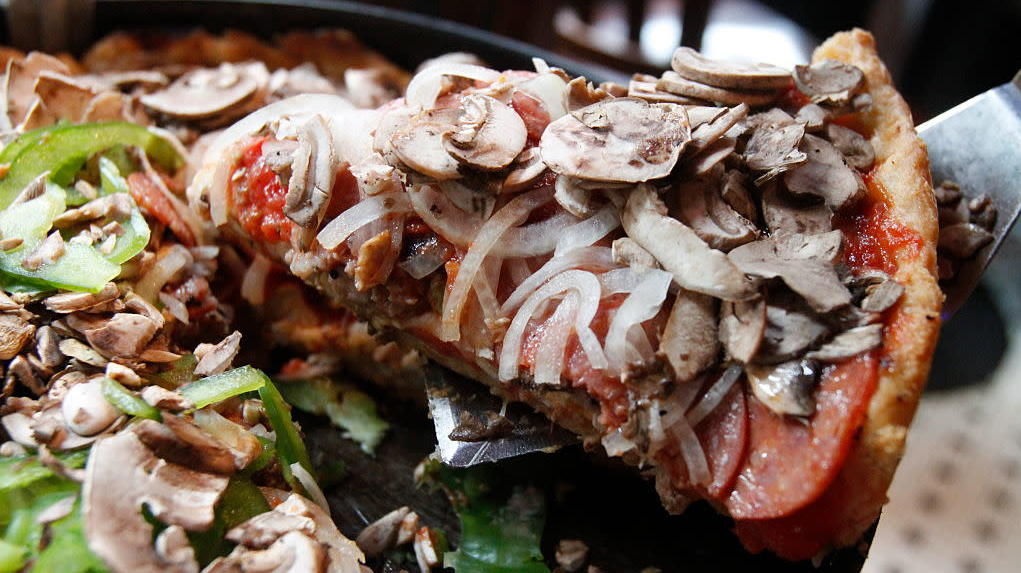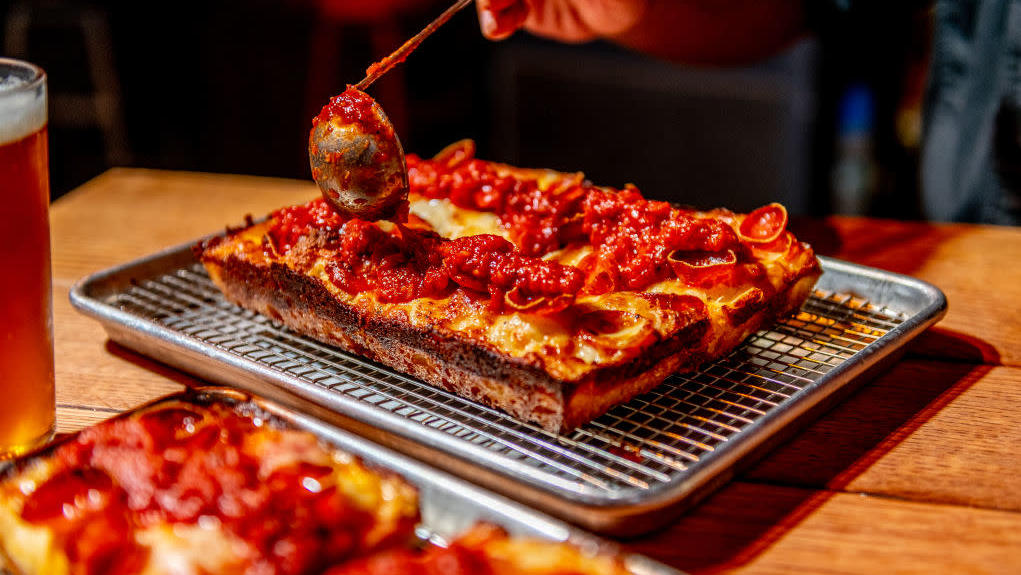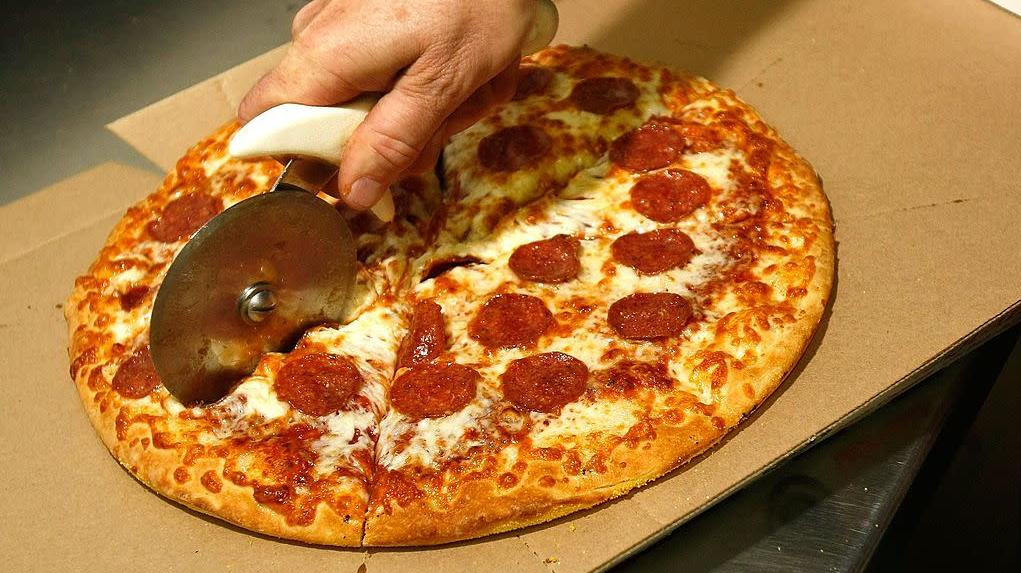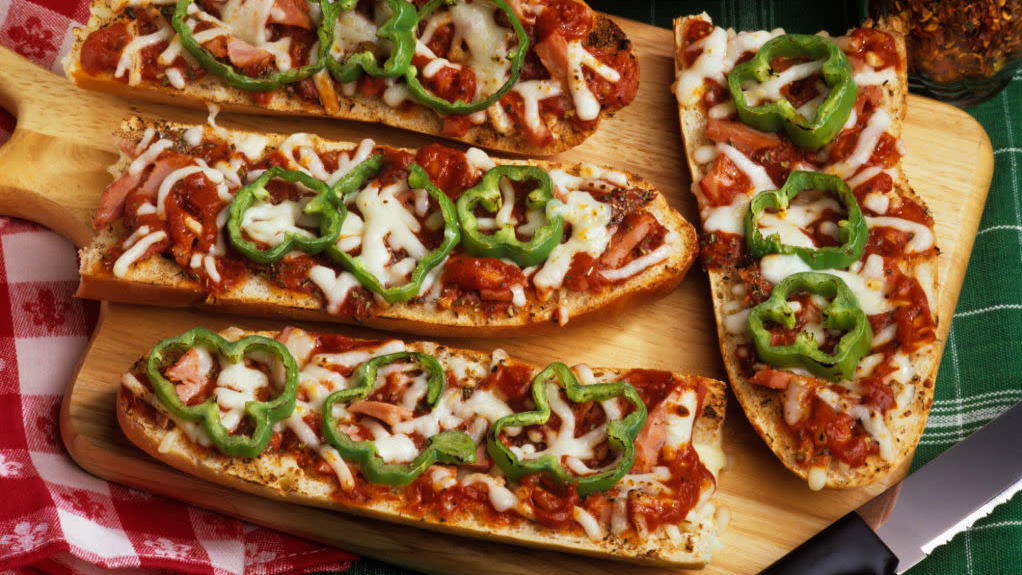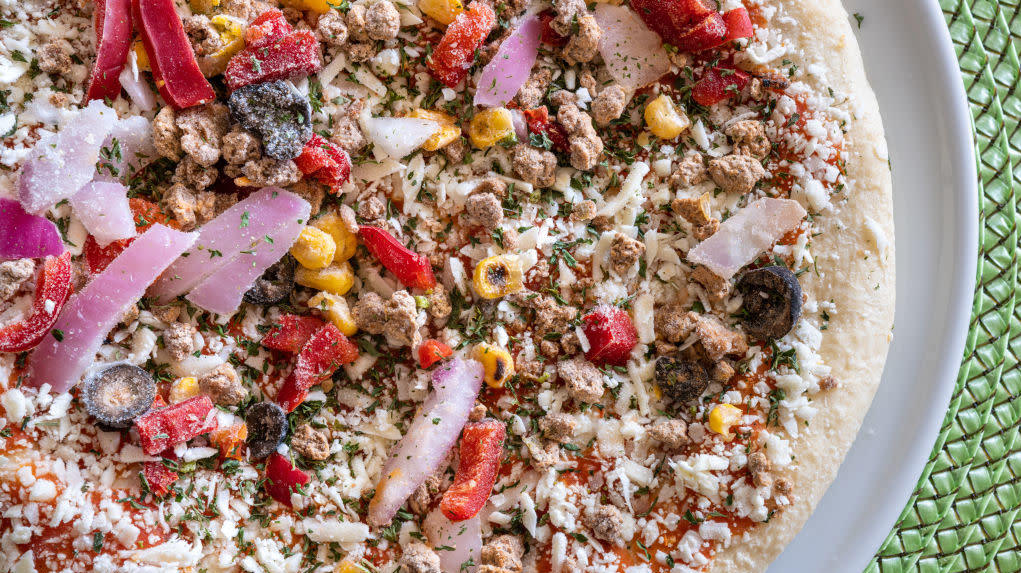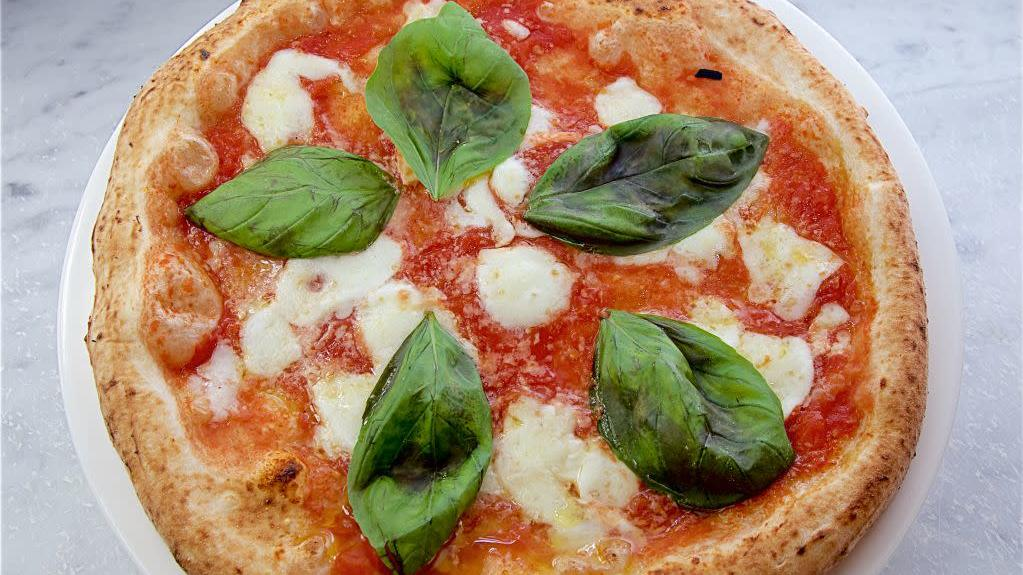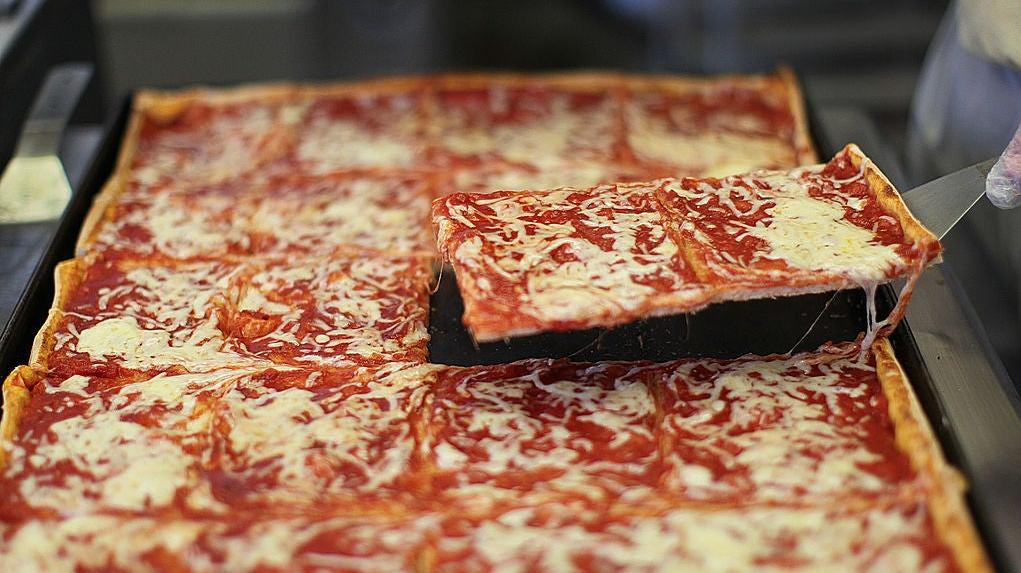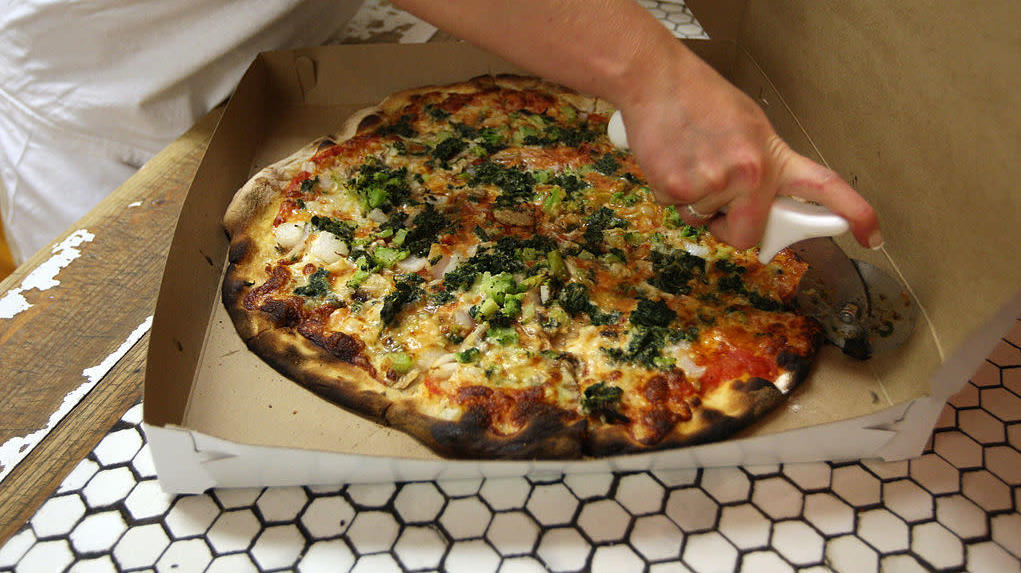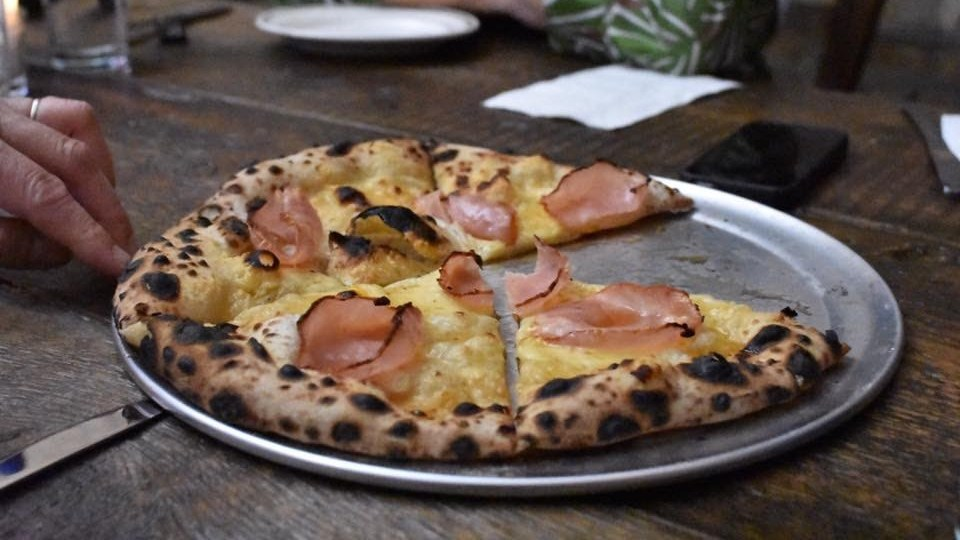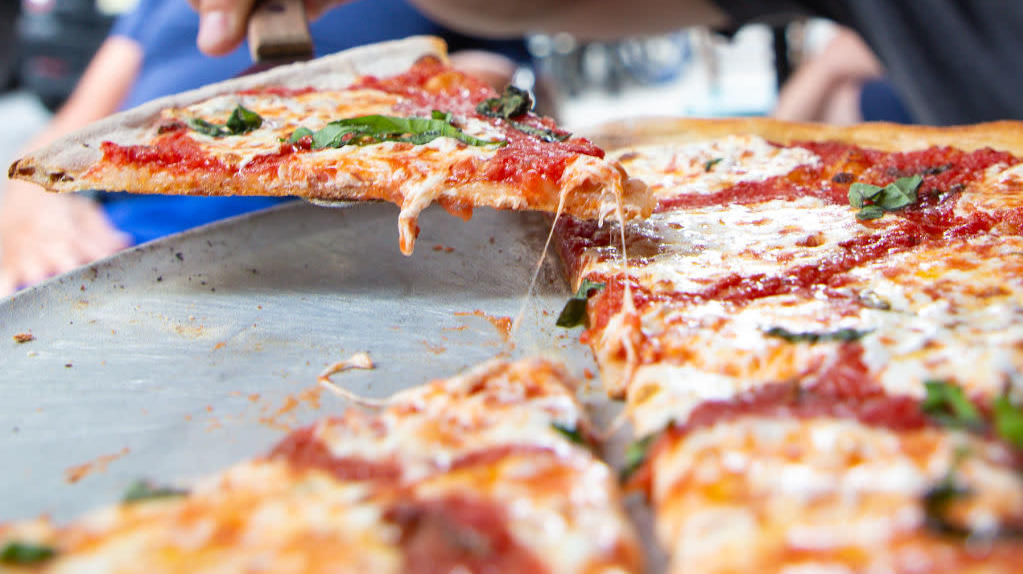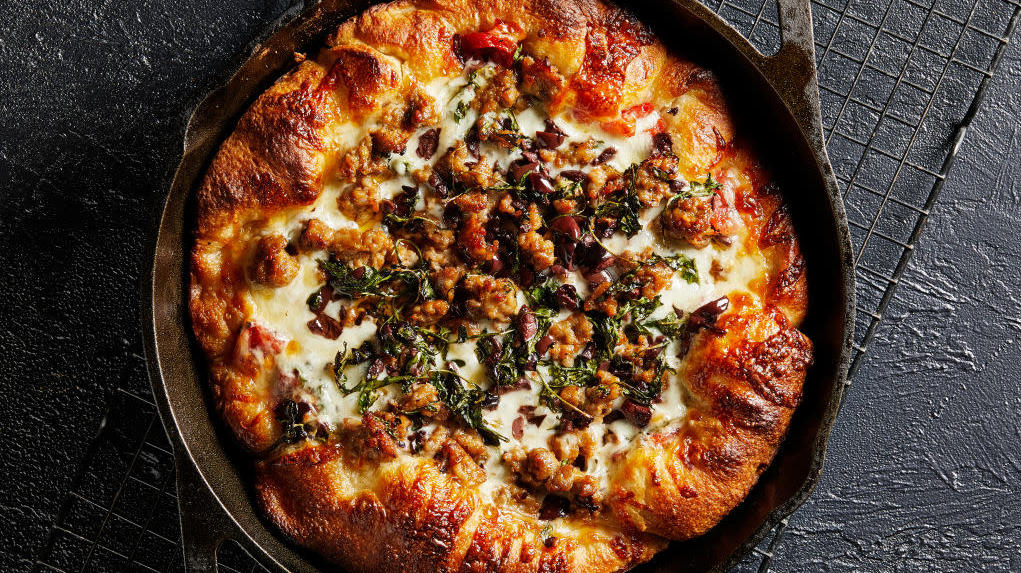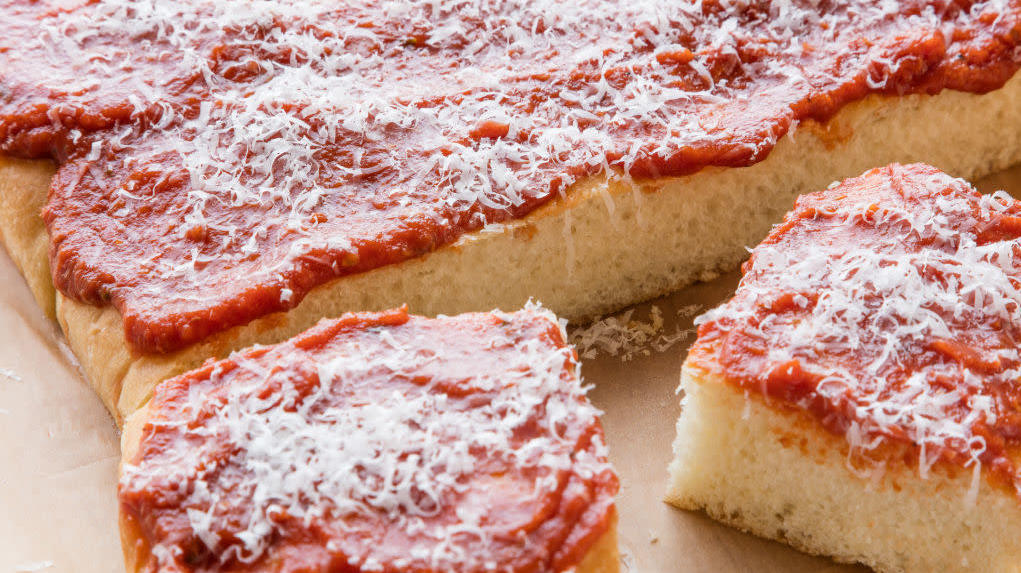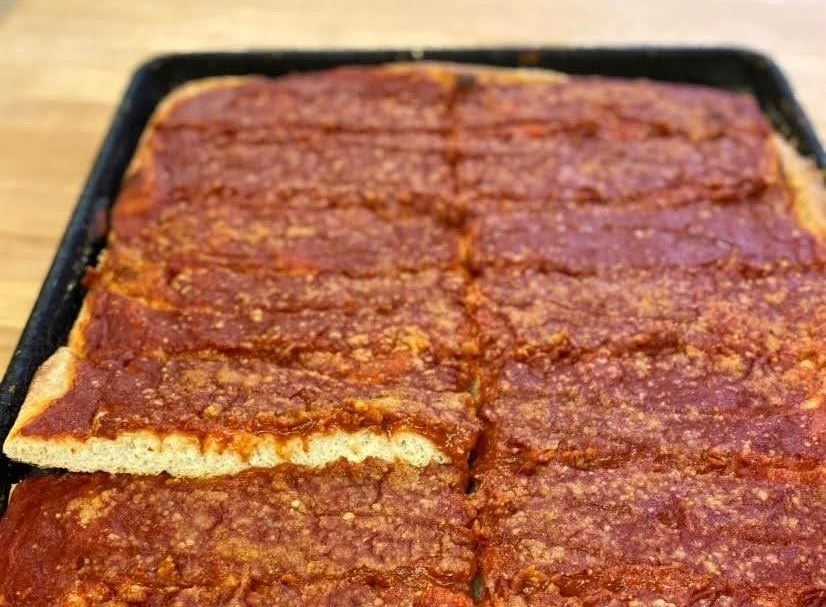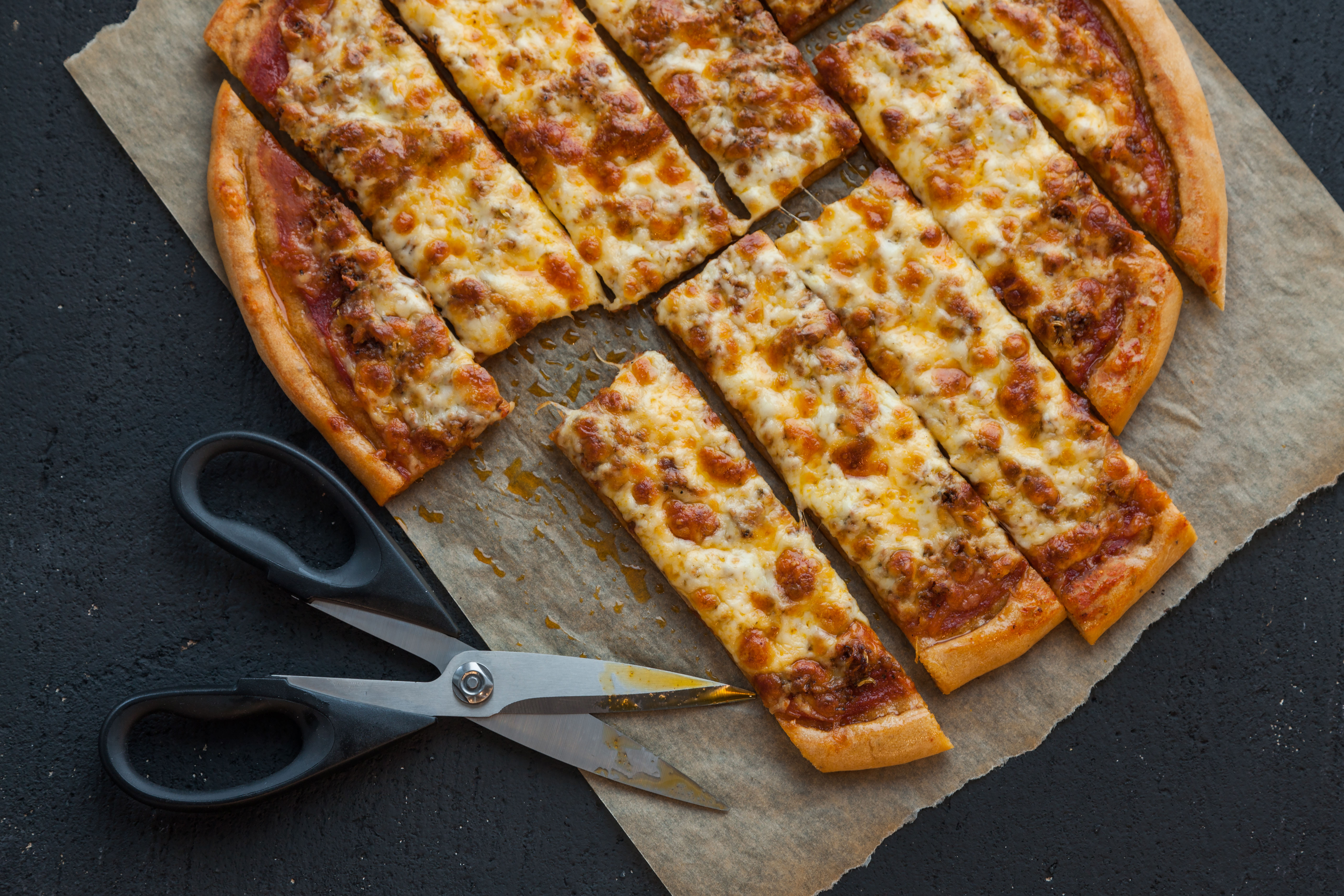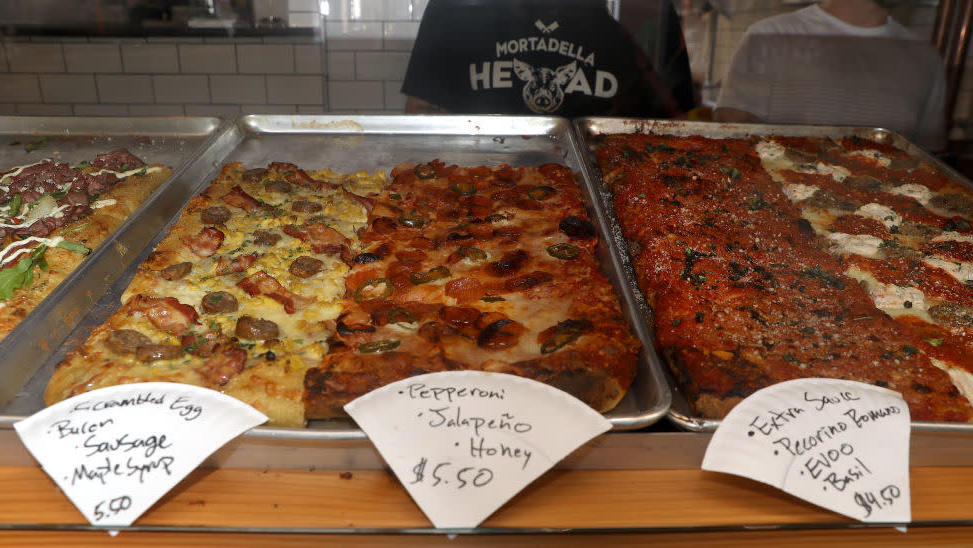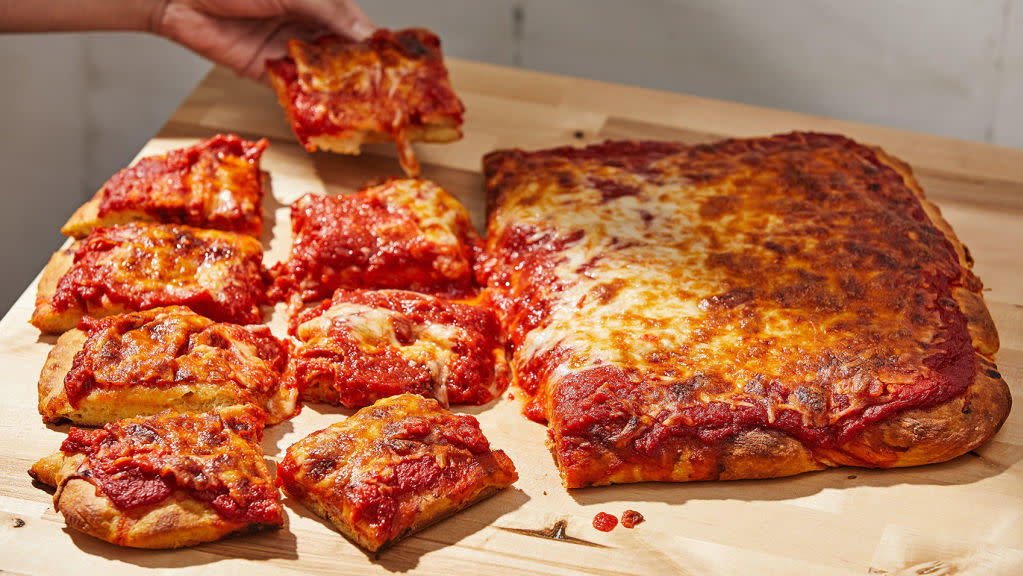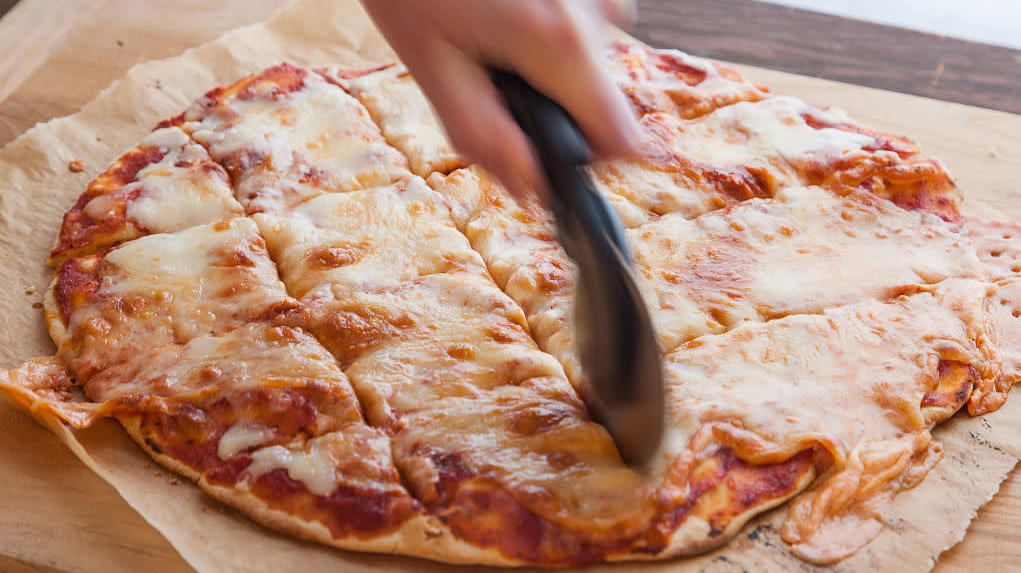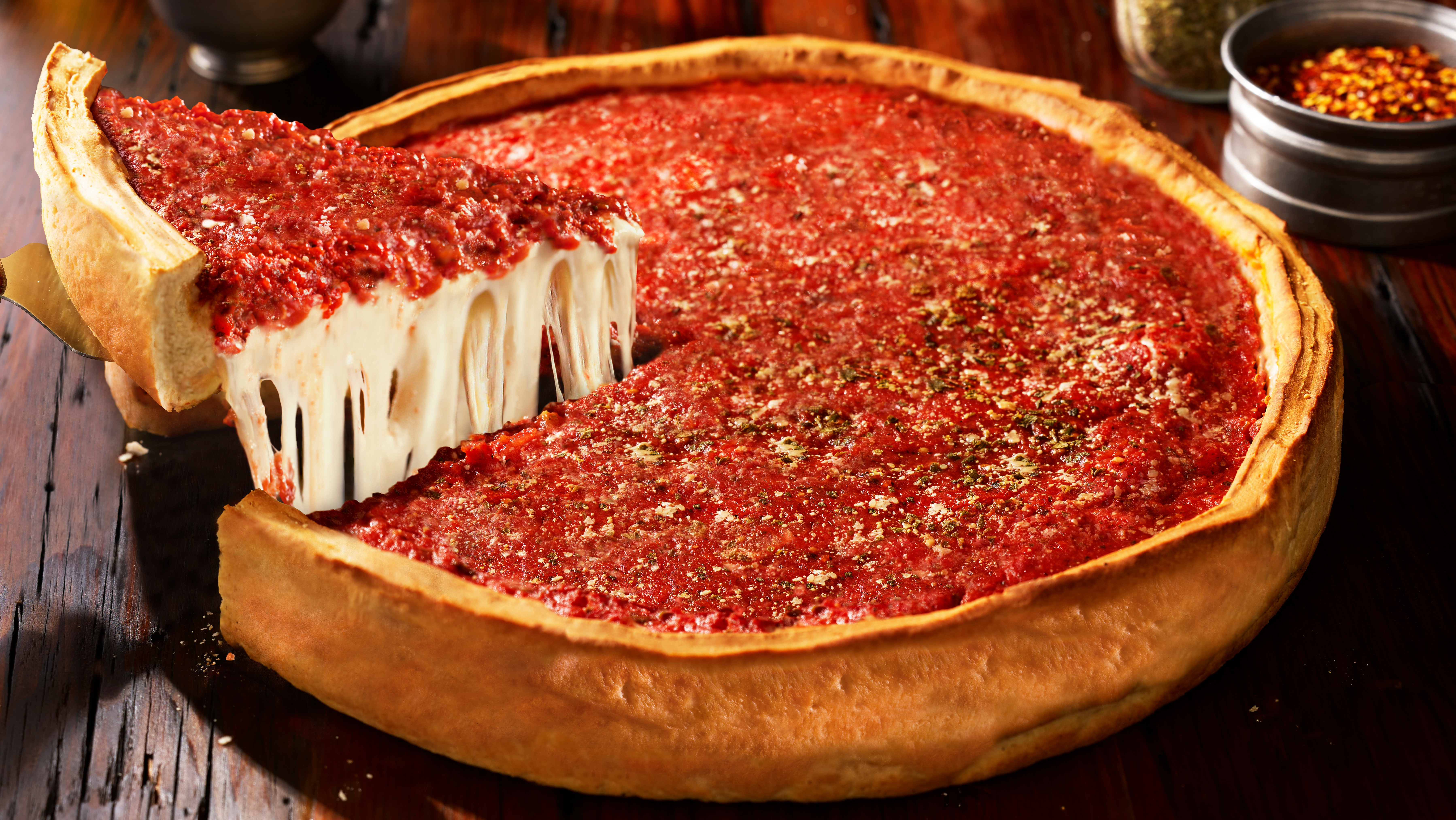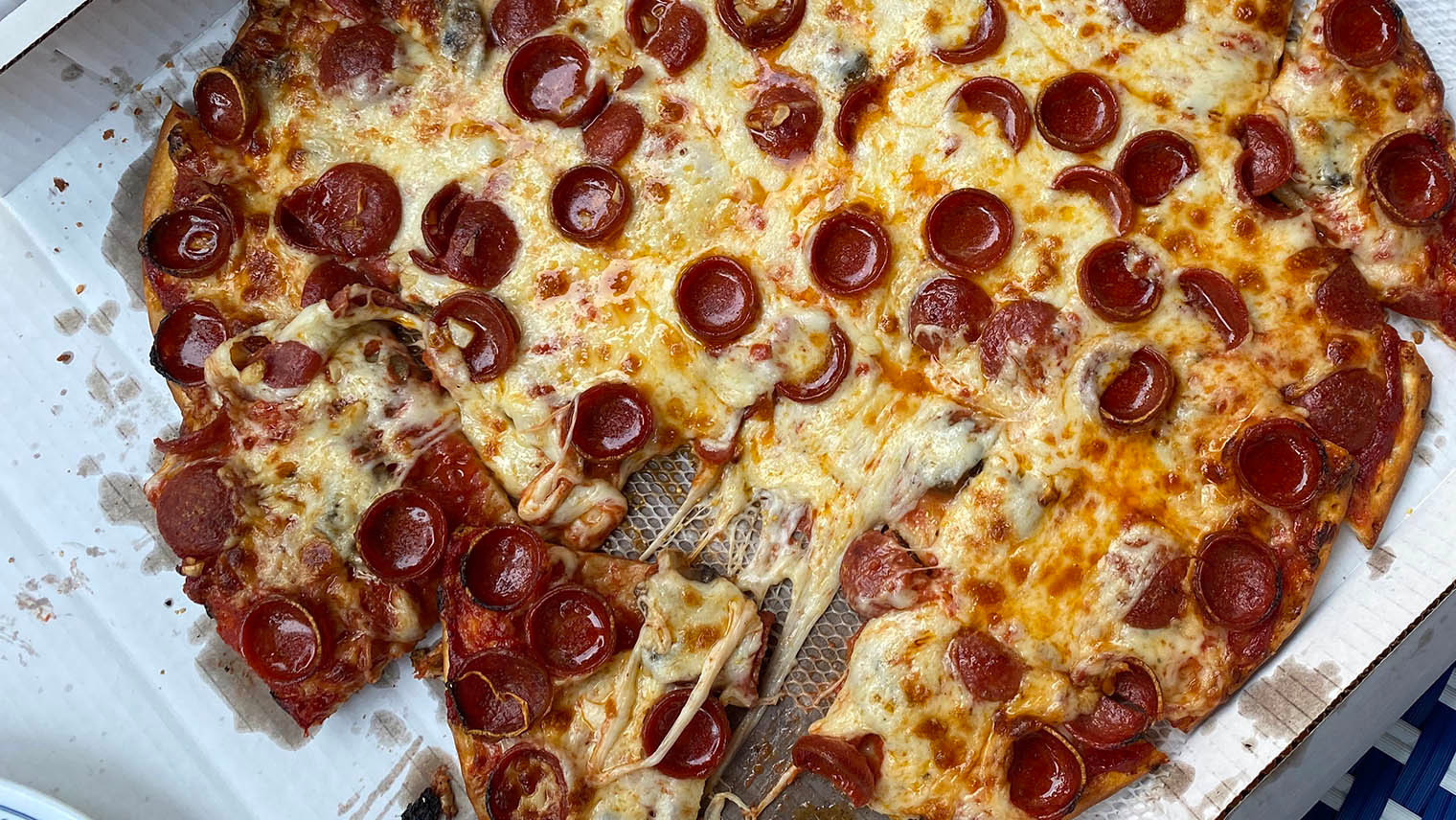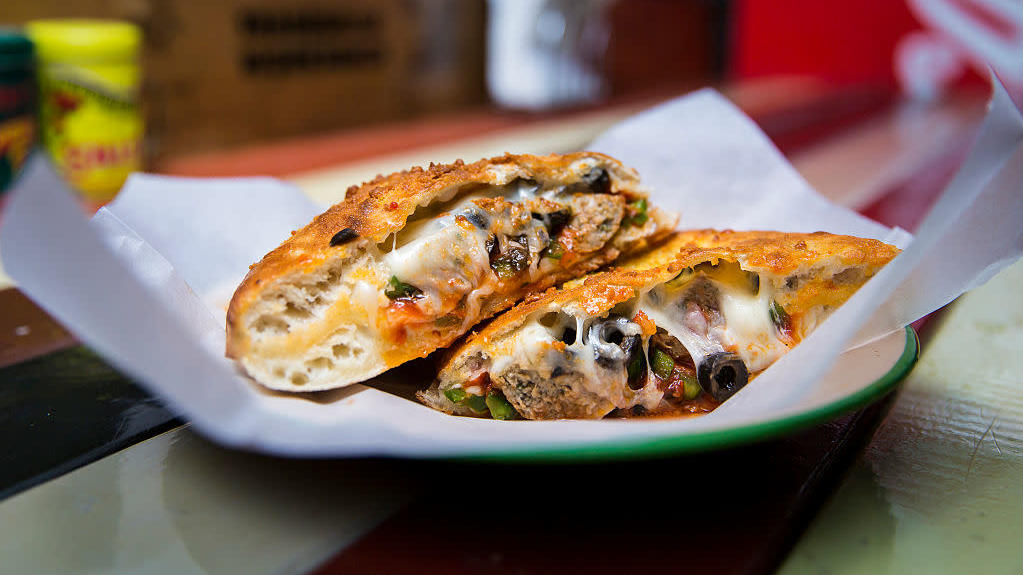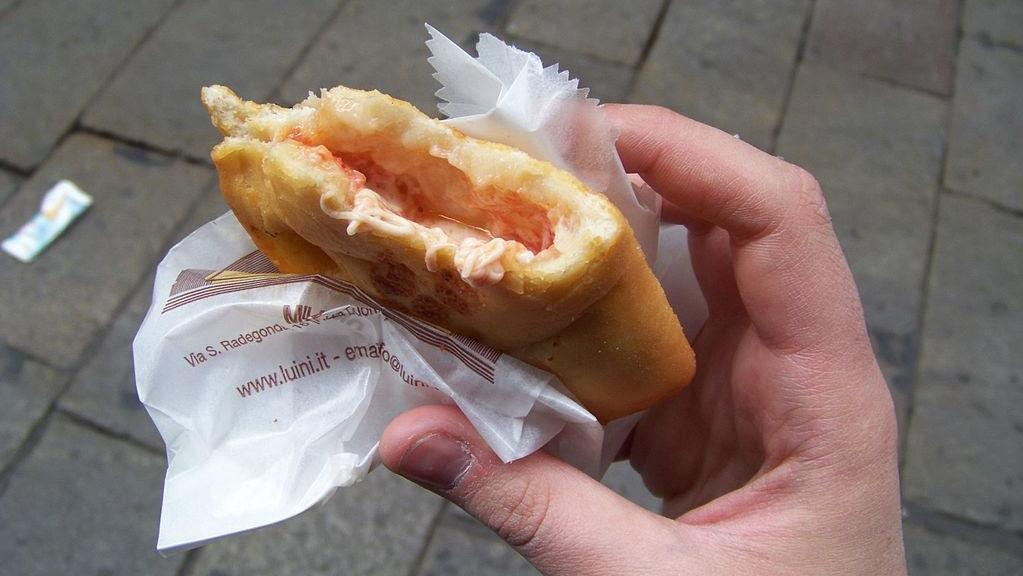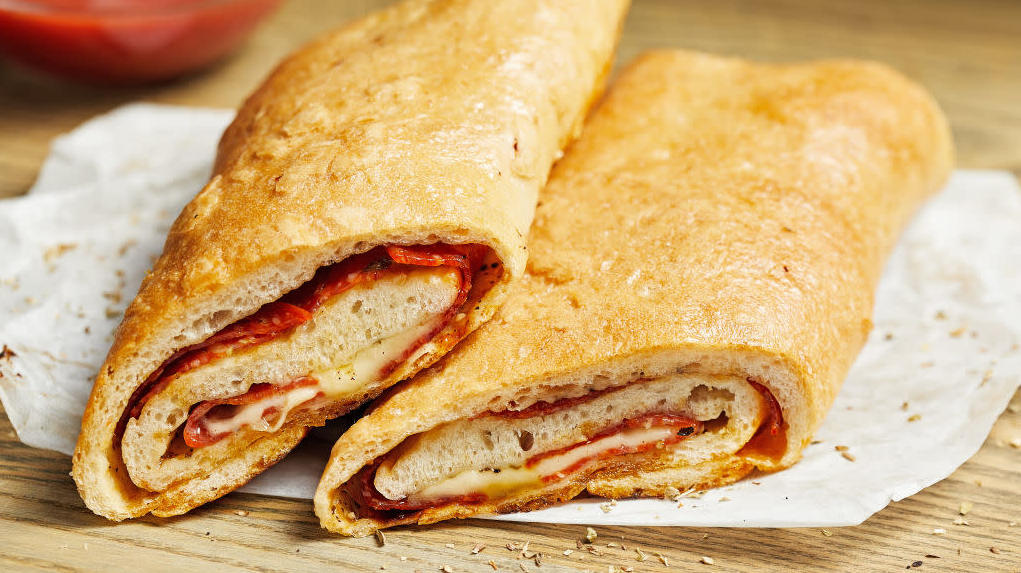The Big Honkin' Guide To America's Regional Pizza Styles
The fact that pizza is made by human hands means that every pie is going to be a little different, no matter how much consistency is baked in (heh) to the process. We wouldn't have it any other way. But since there's no one right way to make a pizza, anyone who considers themselves a pizza devotee has dozens upon dozens of varieties to choose from. We want to make your options clear to you. Thus, we present the Big Honkin' Guide To America's Regional Pizza Styles.
A few quick notes before we begin:
- This is not a ranking of pizza styles. Instead, it's a compendium, meant to guide you in your pizza-eating journey and introduce you to new styles you might never have heard of.
- The list is alphabetized, with a few extra pizza-adjacent items alphabetized separately at the end of the list. (You'll see what we mean by "pizza-adjacent items" when you get there.)
- We're sticking to the United States. Any attempt to document pizza styles more globally would keep us glued to our desks until the 33rd century.
- Not all styles are strictly regional. Some of the pizzas on the list can be found just about everywhere, but are still distinct in the way they're produced, hence their inclusion in the list.
- This guide is not exhaustive. We understand the massive responsibility we have undertaken here, and we want to represent as many pizzas as possible, so if you see that a particular style is not represented, let us know!
Phew. Okay. Ready to learn more about pizza than you ever wanted to know? Let's go.
Note to desktop users: If you'd like to view this story in a scrolling layout, you can narrow your browser window. You can also click "List Slides" at any time to see the full list and navigate to particular entries.
Altoona-Style Pizza
Yes, we're kicking things off with a highly controversial entry. (It's not our fault that "Altoona" comes first in the alphabet!) Out of all the pizzas on this list, Altoona-style is easily one of the slices that most challenges our notion of what pizza is or can be. It hails from the city of Altoona in central Pennsylvania. It consists of a Sicilian-style dough topped with a sweet tomato sauce, a deli-style slice of salami, a ring of bell pepper, and—here's where it gets divisive—a slice of American cheese or Velveeta. Though the entire concoction does seem a little out there, it really does deserve its own entry on this list because it's so unique.
Artisanal Pizza
Artisanal-style pizza is sort of a catch-all title for newer styles of pizza that don't quite fit any crust or topping category. It's an amorphous breed, but it really boils down to the focus on a unique dough, whether that's achieved through technique, style, or ingredients. Pizzeria Bianco in Phoenix may well be the restaurant that started the migration toward this trend today, and it's widely regarded as one of the greatest pizzerias in America.
Bar Pizza
Bar pizza (the East coast variety), despite the generic name, is not just random pizza you find at a bar. It's got a thin, crispy crust and it functions more like a snack to eat with your beer than, say, a big fat meal. A bar pie typically starts being baked off in a pan and is then finished directly on the hearth of the oven. The toppings make their way all the way to the edge of the pie, and the cheese always comes out with a slightly mottled appearance due to an even layer of mozzarella and even bake. Most of the time, expect a triangle cut on this variety.
We acknowledge that the term "bar pizza" can be confusing; there are restaurants that refer to their pizzas as "bar pies" in the Midwest that are cut tavern-style (into squares), so sometimes the moniker does get tossed around inaccurately.
Breakfast Pizza
Breakfast pizza is not so much its own pizza style, but more of a combination of toppings you'd find in a typical American homestyle breakfast—though it's worth mentioning just because it's fun. Toppings aren't necessarily on a base of tomato sauce and cheese; in terms of breakfast pizzas, you've got a little more room to play. Think eggs, sausage gravy, breakfast sausage, bacon, cheddar cheese, potatoes, and we've even seen some whose crusts are made of biscuits. It can be eaten at any time of day. There are no rules. Just pizza.
Brier Hill Pizza
Brier Hill is a super unique style of pizza that, to our knowledge, hasn't really made it out of Youngstown, Ohio in a big way, though dedicated seekers may be able to find it from Pittsburgh to Cleveland. The name refers to its neighborhood of origin, Brier Hill. It's known for its thick sauce, bell peppers, and the use of Romano cheese instead of mozzarella.
Buffalo Pizza
Something that not everyone knows is that Buffalo, New York, is a pizza town through and through. Sure, the rest of the country might know the city for its sauce-covered chicken wings, but its Buffalo pizza pies are just as loved. These pizzas feature semi-sweet sauce and cheese that goes all the way to the edge of the crust. The crust is light and fluffy, nearly focaccia-like. In terms of toppings, Buffalo-style pizzas highly favor cup-and-char pepperoni, the kind that cook and curl up into tiny little cups when they're baked.
California-Style Pizza
California-style pizza can take many forms. This variety of pizza really leans into that breezy style of California cooking that favors local, fresh ingredients. So you can expect to see a variety of toppings, but the most famous examples are that from Spago, Wolfgang Puck's restaurant in Beverly Hills (topped with creme fraiche, smoked salmon, capers, and dill, created by chef Ed LaDou), and of course, California Pizza Kitchen's BBQ Chicken with red onion, smoked gouda, and cilantro (also Ed LaDou!).
Colorado-Style Pizza (aka Colorado Mountain)
Colorado-style pizza, also known as Colorado mountain pie, is another one of those regional delicacies that hasn't quite left its home state. These things are thick, thick, thick. It's a cheese- and topping-heavy pie, but what's especially unique is the crust, which is made with honey and braided around the edge of the pizza. Oh yeah, and since it's loaded with so much stuff, it's sold by the pound instead of by its size. Amazing. Once you're done with the inner part of the pizza, there's a bottle of honey on the table for you to drizzle over your crust and finish it off like dessert, so think of it as a meal in two courses.
Cuban Pizza
Though you might be fooled into thinking that a Cuban pizza is nothing more than a pizza with Cuban sandwich ingredients piled on top, this really is its own style, made popular at pizzerias like Rey's Pizza in Miami. You can expect a slightly thick crust, sauce, and a combination of mozzarella and gouda cheese that creates a cheese crust similar to what you'd find on a Detroit-style pizza. Some people fold the whole pizza in half to eat it like a taco, which honestly sounds like a great way to eat pizza.
D.C. Jumbo Slice
If a slice is known for its size, does it really constitute an entire style? That's debatable, but the D.C. jumbo has morphed into its own pizza tradition, and it's definitely worth noting. The jumbo slice is a late-night mainstay in Washington D.C., specifically in the Adams Morgan neighborhood. Eating this much pizza is probably a good capper on the end of a long night. But it's the only pizza we've ever heard of that's also known for its tendency to create litter: people who can't finish the whole slice often end up tossing it on the street.
Dayton-Style Pizza
Yes, Dayton, Ohio has its own style of pizza, featuring a thin, salty, cracker-like crust. It's square cut, like most Midwestern pizzas, except the squares are cut notably smaller; each piece can be eaten in just a couple bites. Dayton-style also goes heavy-handed on toppings.
Deep Dish Pizza
Come on, everyone, let's please not start a fight over this. Yes, deep dish pizza is from our hometown of Chicago, and yes, it counts as pizza (not a casserole). In fact, it's one of the great culinary icons of the city. No, it is not the only kind of pizza we eat in Chicago. But comparing it to New York pizza in any way just sets us off down an endless, unsatisfying path of useless repetition that goes nowhere. Now, with that rant out of the way...
Deep dish is a variety of tall pan pizza, loaded with a shameless amount of cheese, then the sauce is ladled on top, then it's baked off. The sauce varies from place to place, some pizzerias make it smooth, others chunky and rustic. Crust thickness can vary, and so can styles; you can have one with cornmeal baked on the bottom, or bready varieties that get more of their height from dough than cheese. It's filling, comically big, and because of that, has the added bonus of being entertaining to eat. Make sure you eat it piping hot before the cheese turns into a brick, and using a fork and knife is just fine. Sometimes it's absolutely necessary.
Detroit-Style Pizza
Detroit pizza has come quite a way, and that's a gift for all. This American offshoot of Sicilian-style has become very popular, spawning versions at different chains like Little Caesars and Jet's (Turbo Crust for life!). This is a square-cut pizza with a fluffy dough, baked in a specific steel pan, with cheese (brick cheese) pushed all the way to the edge. The sauce is baked on top of the cheese in big fat stripes. During the baking process, the cheese melts between the crust and the pan, creating a caramelized crunchy exterior that is easily the best bite of the slice. Just a hint: Fight for the corner slices. They have double the cheese edges.
Fast Food Pizza
Fast food pizza absolutely needs a mention on this list, because whether or not you've got a strong opinion on it, this is what a hell of a lot of people are ordering on any given day, and it's what many people consider their favorite pizza. Whether it's a supergiant brand like Domino's or the super affordable Little Caesars (which has helped so many get by on very little), fast food pizza is a powerhouse category. Now, obviously, it doesn't encompass one particular style of pizza—the biggest chains release their own versions of various styles all the time—but if you're 10 years old and your parents are ordering 20 pizzas for your birthday pizza party, you know exactly what sort of product will be delivered and consumed.
French Bread Pizza
Ah, French bread pizza, the after-school favorite of teenagers, a late-night snack for adults, and a reliable standby for everyone in between who doesn't feel like committing to making or eating a whole pizza. You know what this is: a horizontally split loaf of French bread, sauce, cheese, and toppings, toasted until the crust is crispy while the top usually stays a little soggy. Who doesn't love the stuff?
Frozen Pizza
Like fast food pizza, this definitely belongs on the list for its own reasons: convenience, affordability, and variety. These thin discs that are ready for the oven have saved so many dinners in crisis, and can even feed the pickiest of them all. It's sort of like how instant ramen is still ramen, and sure, the real thing is better, but they each have their places. The history of frozen pizza goes all the way back to the 1950s. What would we do without it?
Grandma Pizza
Grandma style is a little confusing, but we're here to set the record straight for you. This Long Island original is very similar to the rectangular, more bready Sicilian style (which is more like focaccia). If you've ever wondered about the name, it's because this is a style of pizza that was frequently made at home; grandmothers used to make it with whatever they had on hand, as the stories go. These pies are thinner than Sicilians, and often with sauce on top of the cheese, resulting in a slice that's almost never soggy.
Neapolitan
Neapolitan style, the great OG of all pizza, hails from Naples, Italy. This is a dish so revered that authentic Neapolitan pizza must be certified by an association called Associazione Verace Pizza Napoletana (VPN for short). The pizza needs to be prepared according to a certain set of rules in order to qualify: It must be baked in a wood-fired oven operating at around 900 degrees Fahrenheit (in some circumstances, gas is okay), the dough must be kneaded by hand or with approved equipment, and only a few types of cooking tools are allowed during the process.
Typically, the flours used in a Neapolitan pizza are known as Type 0 or Type 00; the "0" references how finely the flour is milled. Type 00 is milled ultrafine, resulting in a crust that's fluffy and chewy as opposed to crunchy and crackly. After it's baked in the super-hot oven (which only takes around 90 seconds—whew), you'll be rewarded with a soft blistered crust with a slight hint of char encompassing its bright tomato and creamy fresh mozzarella topping.
New England Beach Pizza
This is a type of pizza you've probably never seen outside of New England. New England beach pizza is very thin, flaky, and crisp. It's baked in a sheet tray, sold by the slice, some with sauces that can verge on being very sweet. You have the option to add a circle of provolone cheese onto each slice, baked to order. It was made famous at places like Tripoli's and Cristy's Pizza. For some it's nostalgic, for others, only mediocre, or both.
New England Greek Pizza
Greek-style pizza, mainly found throughout New England, is unique thanks to the shallow pan it's baked in, unlike, say, a deep dish or Detroit-style pie. While many pizzas are baked directly on the deck of the oven, Greek-style never leaves the pan, that is, until you eat it. They've got a reputation for being pretty oily due to the fact that the pan is well-greased before it even goes into the oven. It's not necessarily for everyone, but pizza almost never fails to please.
New Haven Pizza
New Haven–style pizza hails from Connecticut, with a satisfyingly chewy blistered outer crust that's sort of a cross between Neapolitan and New York–style, usually in a blobby hand-stretched shape that's more like an oval than a circle. New Haven's big claim to fame is the white clam pizza, which originated at Frank Pepe's Pizzeria Napoletana. It features mozzarella, garlic, olive oil, and clams, and if you've never had this topping combination, you haven't lived yet.
Neo-Neapolitan Pizza
This one's a little confusing, because Neapolitan pizza has such a specific definition right down to how the dough is made and how the pizza is baked off in a wood-fired oven. But since it's so rigidly defined, any variation or riff is immediately a slightly different style; thus, we've arrived at a "neo" version of Neapolitan.
Whether it's a tweak in the dough, cooking in a different type of oven, or playful, even dramatic ingredients you won't find on a traditional margherita, Neo-Neapolitan-style pizza has the bones of an old classic but is just dressed up a little differently. It's still got that great blistered char on the crust, though.
New York–Style Pizza
New York–style pizza is easily the most argument-inducing food on this entire list (and beyond). It's a celebration of ratios and textures; expect a thin, foldable crispy crust with plenty of satisfying chew, an even layer of sauce, and a blanket of mozzarella that's generous without being over the top. It's an iconic pizza for good reason.
When executed perfectly, a New York slice is something absolutely unforgettable, both in its simplicity and in how complex a good slice can actually be. There are a few rules: It's a slice of pizza, not a piece. A cheese slice is called a plain slice. Fold it as you eat it. And if a pizza joint's plain slice is no good, there's not a ton of hope for the other pies on the menu.
Old Forge Pizza
Old Forge is yet another example of a pizza style that's really locked into its home territory. It's served at pizza cafes (as the locals call them) in Old Forge, Pennsylvania, a town of about 8,000 people. These are sheet pan concoctions that come in rectangles, and instead of being referred to as a pie, entire pizzas are called "trays" as a reference to the pans they're baked in. Unlike New York's predilection for the term "slice," a single piece is called a "cut."
These pies come in red and white varieties, and each pizza cafe has its own secret blend of cheeses—there are no specific rules about what kind of cheese belongs on a tray, which makes each cafe's recipe so unique. The crumb is tighter than, say, focaccia, resulting in a denser, chewier bite. The white version of Old Forge pizza might as well be its own style, as it's stuffed, with a layer of dough on the bottom and on top, and it's filled with plenty of cheese and whichever fillings you're in the mood for.
Fun fact: Old Forge is known as the "pizza capital of the United States." It's a self-awarded title, much like Michael Jackson calling himself "The King of Pop." But it's a superlative that people use proudly, and we have no reason to dispute it.
Ohio Valley Pizza
Ohio Valley-style pizza has a very unique defining characteristic like nothing else on this list: After the crust is baked with the tomato sauce, the toppings are added cold. It's generally sold by the square cut rather than the entire pizza. As for why the toppings are tossed on last, there's a theory that since the original pans used to bake these pizzas off were so thick, the cheese would burn before the rest of it was finished. Incidentally, this is why deep dish pizza tends to have the sauce spread on top, to insulate the cheese from the high baking temperatures.
Most places that sell Ohio Valley pizza use provolone as the main topping cheese instead of low-moisture mozzarella, which is yet another thing that marks it as a unique and interesting style.
Pan Pizza
Pan pizza is less of a specific dough style and more of a baking method: these pizzas are baked in deep metal pans of varying types, usually made of cast iron or steel. Pizza Hut is the prime example of pan pizza for many people growing up. This style of baking off the pizza typically results in a crust that's nearly fried in texture. Examples of regional styles baked in pans include deep dish, Detroit-style, and stuffed.
Philly Tomato Pie
A Philly tomato pie (not to be confused with a Trenton tomato pie, also on this list), is a square focaccia-like bread topped with a thick layer of tomato sauce. In this style, the tomatoes are the star, not cheese, as some versions have no cheese whatsoever. Others have a small scattering of Parmesan to finish it off. It's eaten cold or at room temperature. They are deceptively simple on paper, but a good tomato pie slice at room temp can be absolutely exceptional.
Pizza Bianca
Pizza bianca (literally translated into "white pizza") is proof that a fantastic pizza really can't stand on its own without a delicious dough. That's the foundation of the whole thing, and its quality is important enough that even varieties of pizza bianca with no toppings other than salt and olive oil get to be called pizza. Some versions do have a little cheese on top, but that's the icing on the cake.
Pizza Strips
Pizza strips are local to Rhode Island and mainly sold in bakeries. They're pretty much the same as a Philly tomato pie, similar to a focaccia with tomato sauce on top, eaten at room temperature. Rather than being cut into squares, however, they're cut into rectangles (or "strips"). Whether or not that makes a difference is up for debate, but considering people like to argue about triangle-cut vs. square-cut pizza, the devil is in the details.
Quad Cities Pizza
Quad City–style pizza is unique in a few significant ways. One of its defining characteristics is the presence of malt in the crust, creating a slightly sweeter overall dough profile. It's always cut into strips (with scissors!) rather than squares or triangle slices. There's a heavy hand on the cheese, and the tomato sauce veers toward the spicier side. If you're a fan of sausage on your pizza, Quad City pizzas have a finely crumbled version as opposed to coins or big chunks.
A glowing example of Quad City pizza is a taco pizza, topped with lettuce, tomatoes, and taco chips, and it's served with a side of taco sauce and sometimes sour cream. It's truly a sight to behold, and even more fun to eat.
Roman (pizza al taglio)
Roman pizza, or pizza al taglio (Italian for "pizza by the cut"), is another rectangular style, usually cut by scissors, and is sold by weight. The crust is airy, fluffy, and light, and can come with a wide assortment of toppings, both baked on or freshly added post-bake. You might think you're not a fan of potatoes on pizza, but try tracking down a slice of potato and rosemary pizza al taglio and see how you feel after your first bite.
Sfincione
Sfincione is a variety of Sicilian-style pizza. It's got a focaccia-like bread structure, topped with tomato sauce, onions, grated Caciocavallo cheese (a grated sheep's milk cheese from Italy), sometimes anchovies, and a dose of breadcrumbs sprinkled on top. It's a traditional Christmas Eve and New Year's Eve food, but you can catch it in some Italian bakeries here year-round, if you poke around for a bit.
Sicilian Pizza
Think of Sicilian style sort of like focaccia pizza. It's known for being bready, spongy, and baked in a generously oiled baking pan, resulting in a nearly fried bottom crust. It's usually topped with a generous helping of tomato sauce and cheese like mozzarella (sometimes cheese first, sauce on top), or just a grated hard cheese like Parmesan. Most of the time you'll see it come straight from a rectangular tray, but a round version isn't unheard of either. It's thick, hearty, and the basis of so many modern pizza styles you see today.
St. Louis–Style Pizza
People have strong opinions about St. Louis–style pizza, but even the haters have to admit it's unique. Its crisp, cracker-like crust is made without yeast; think of it almost like a pizza-topped saltine, or, as J. Kenji Lopez-Alt puts it, nachos. Beyond this, St. Louis style sets itself apart with its choice of cheese. It's topped with something you can't get easily anywhere else: Provel.
Think of Provel like a smokier version of American cheese. It's cream-colored, a processed blend of provolone, cheddar, and Swiss. It melts like American cheese, so when it melts, it doesn't stretch, but instead becomes gooey, like a sauce.
Stuffed Pizza
Stuffed pizza sometimes confuses Chicagoans and non-Chicagoans alike. It looks almost exactly like deep dish, which is correct in that it's a variant of deep dish: it's tall, thick, and full of cheese. But there's a thin layer of dough on top of the cheese and fillings to encase them, and then the sauce is ladled on top. This is the deepest version of deep dish pizza in Chicago. Its cheese pull can span multiple feet if you cut a slice while it's piping hot, and for you social media fiends out there, it makes for a really good photo, video, or Boomerang.
Thin Crust/Tavern-Style/Tavern-Cut Pizza
Thin crust pizza is the kind we treasure in the Midwest. It's what we eat most often in Chicago (not deep dish!), and it varies from a thin, ultra-crispy crust to slightly thicker, softer varieties, depending on the restaurant. We tend to celebrate the toppings most, with a heavy hand on the sauce and cheese. A lot of these pizzas are made by rolling out the dough through sheeters to create a uniform thinness that would be otherwise difficult to achieve by hand.
The term "tavern cut" refers to the fact that this style originated in bars. It was served for free to encourage patrons to keep drinking instead of leaving the tavern to go find food. Smaller pieces were easier to dole out as a snack, so the pizza was cut into squares, as it remains today. An advanced move is to ask for the pizza "well-done"; you'll get a deeper caramelization on the cheese, plus a crisper crust.
Trenton Tomato Pie
Tomato pie from Trenton, New Jersey, not be confused with Philly's tomato pie, is a round pie that's sort of a Neapolitan-style derivative, with one key difference being that the sauce is applied on top of the cheese. Placing the sauce on top not only keeps the dough from getting soggy quickly, but it also dries the sauce out so that it becomes thicker in texture, giving the pizza a more concentrated tomato flavor.
Pizza-adjacent: Bagel Bites
Oh, Bagel Bites, the after-school treat that fueled, and still fuels, generations. What's left to say about those tiny bagels topped with pizza ingredients? As the commercials warbled, "When pizza's on a bagel, you can have pizza anytime!" They're included lovingly in this list because you microwave a batch of these when you're craving pizza, not bagels. Case closed.
Pizza-adjacent: Calzones
A calzone, not to be confused with a stromboli, is basically a folded-over pizza that's sealed shut and baked off. Think of it kind of like a pizza turnover where your favorite toppings have become your favorite fillings. Calzones sometimes contain sauce, and if it's not inside the calzone, it's often served on the side.
Pizza-adjacent: Panzerotti
Don't mistake a panzerotto (plural: panzerotti) for a calzone, because they're different beasts altogether. Panzerotti almost always have one key delicious factor distinguishing them from calzones: they're fried. You can expect panzerotti to be filled with tomato sauce, mozzarella, and any assorted fillings of your choice, and they're also usually small enough to carry around by hand, which makes for good street food—just don't burn your tongue on the fillings.
Pizza-adjacent: Pepperoni Rolls
Pepperoni rolls are a regional snack found in West Virginia and near the Appalachian mountains. Nope, they aren't pizza rolls. They're bread rolls with sticks or slices of pepperoni baked in, sometimes cheese. Pepperoni rolls are a convenience store staple throughout the region, so you can duck into a gas station and stroll out with one in no time. Would you even consider them a pizza-adjacent item? We think they could be long lost cousins. At one point they were almost deemed illegal based on a technicality, but everything worked out in the end.
Pizza-adjacent: Pinsa
Some people argue that pinsa is a form of pizza, while others contend it's a different beast altogether. The difference lies in the ingredients in the dough. Pizza has an all-wheat flour crust, while pinsa has a combination of flours like soy, rice, and wheat, in some combination. The result is something much lighter than pizza dough, and some argue that this makes it healthier than normal pizza. The toppings for pinsa are pretty standard, like the tomato sauce and cheese you'd find on a pizza.
Pizza-adjacent: Pizza Puffs
Pizza puffs are a regional Chicago snack. Just outside of the Chicago area, the presence of pizza puffs dwindles exponentially. If you've never seen one, chances are, based off the name, you might imagine it as something akin to a Totino's pizza roll, but that's not quite it. A pizza puff is a deep-fried rectangle filled with pizza sauce, meat fillings, and finely cubed mozzarella, always served blisteringly hot; think of it like a pizza chimichanga. They're almost exclusively found at mom and pop hot dog stands on the sides menu (beside the french fries). They won't run you more than $4, and no matter where you buy one, it's likely to have been produced by a company called Iltaco.
Pizza-adjacent: Pizza Rolls
Pizza rolls, as you probably know, are found in the frozen section of pretty much any local grocery store. They were invented by a man named Jeno Paulucci, whose original version actually involved filling egg roll wrappers with pizza toppings. Genius. The name might not be familiar to you, but Paulucci created a company called Jeno's Pizza Rolls that was eventually sold to Pillsbury, who changed the name to—you guessed it—Totino's.
Pizza-adjacent: Stromboli
People often conflate calzones and strombolis, but they are two distinct specimens. You can tell the difference between a calzone and a stromboli by the shape: a calzone is a half-moon (since it's basically a folded-over pizza) while a stromboli is more of a rolled or filled cylinder, layered with cheese, veggies, or meat. Another difference: Stromboli typically does not contain any sauce.
Pizza-adjacent: Vesuvio (bombe)
A Vesuvio (or bombe, aka "bomb") is sort of like a calzone, but instead of being one pizza crust folded over the center, it's a flat pizza sealed within two Neapolitan crusts, one on on top of the other. The interior is filled with typical pizza ingredients, but when it bakes in the oven, a Vesuvio puffs up into an entertaining ball. If there's a slit or puncture on top, steam shoots out—sort of like a volcano, hence the name.
